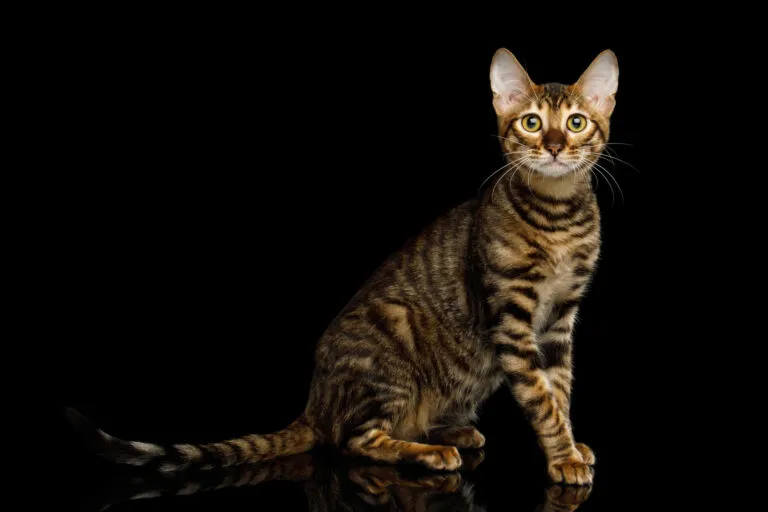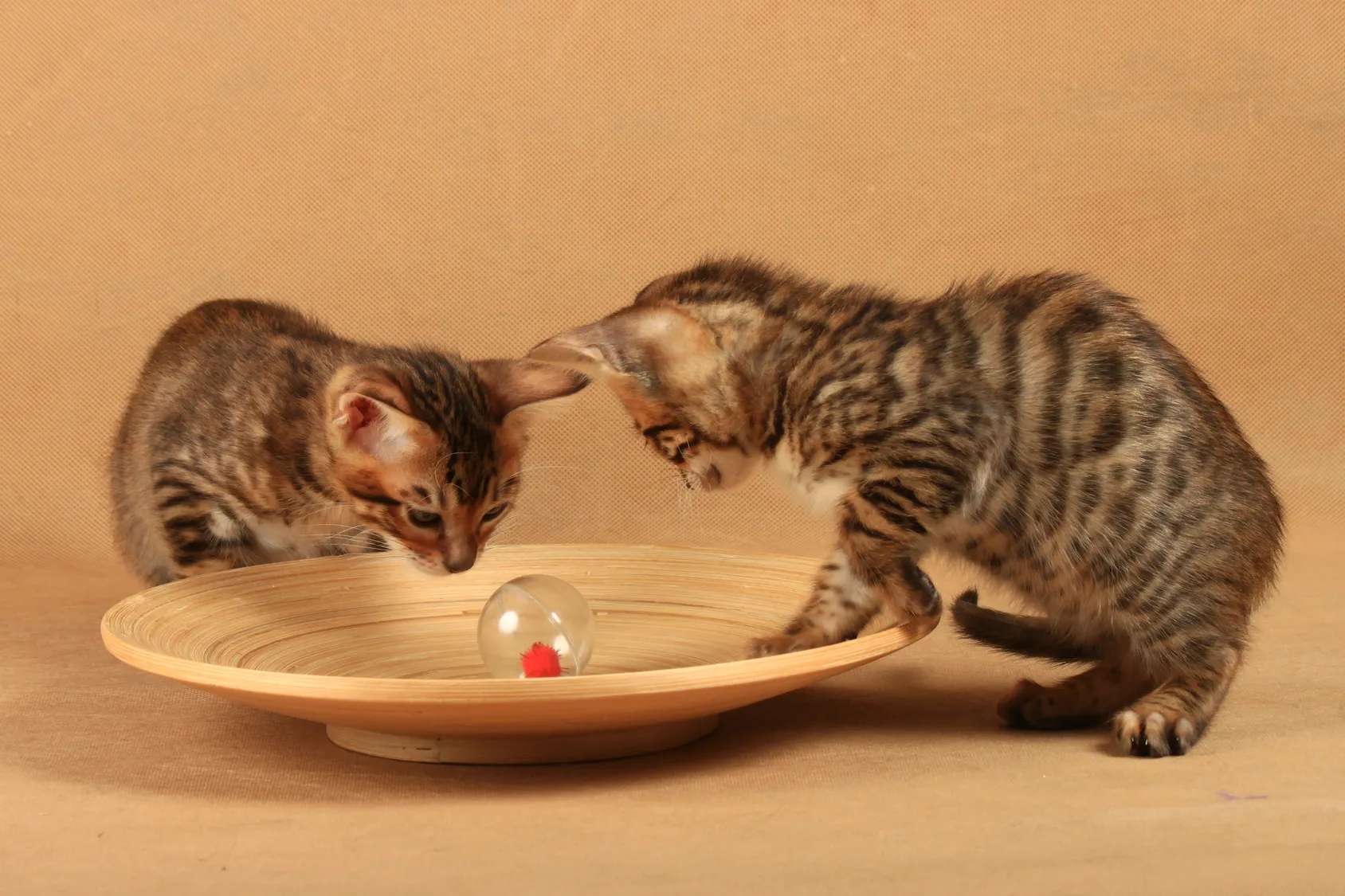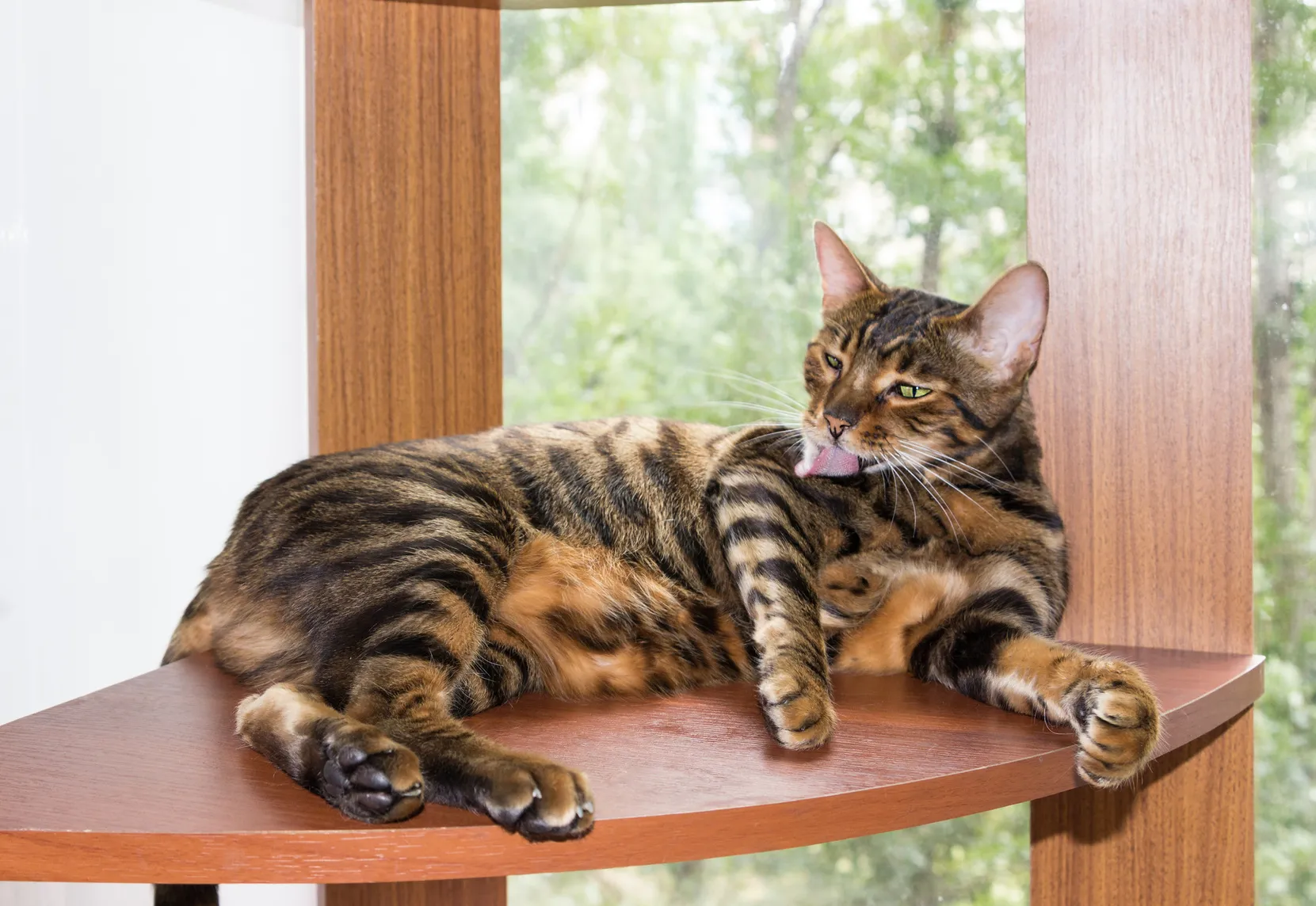Maine Coon
The Maine Coon has become one of the most popular cat breeds in the world. This is probably due to its majestic appearance, robust nature and great character.
Originating from the US, the exclusive Toyger “designer cat” is a domestic cat bred with the aim of resembling a tiger in cat form. Hence, the name is made up of “toy” and the ending of “tiger”. Although the Toyger's name may suggest so, a pet should of course not be treated as a toy, but rather as a beloved animal with which you can enjoy plenty of fun and games.

© seregraff / stock.adobe.com
In the late 1980s, Judy Sugden began breeding a cat that phenotypically resembled a tiger. In order to achieve this tiger-like appearance, she had to intensify the tiger tabby elements so that the black stripes ran downwards close to the body, on the face and along the temples.
The Bengal male Millwood Rumpled Spotskin and domestic female Scrapmetal were the basis of the breeding programme. Since 2007, it has been officially recognised as the Californian Toyger.
It is specified in the standard that the Toyger is a “designer cat”. Breeders define their objectives through morphing, i.e. generating graphic images of the ideal Toyger. In this way, they wish to achieve and optimise their breeding goal of producing a small big cat for the home.
Toygers are found solely with brown tabby markings. The correct name for this is Brown Tabby Mackerel. Their very soft and silky short fur to some extent resembles that of a tiger.
The Toyger is medium-sized and has an athletic, muscular and elongated body with a broad chest, medium-length legs and large, strong paws. These big cats in miniature format reach 3.5kg in weight with females and up to 4.5kg with males. The appearance is as powerful as you would expect from a tiger: the paws are large and the distance from the body to the floor is the same as the body height.
The Toyger’s body is long and broad. Its ears tend to be small and round in shape.
The same applies to the Toyger’s deep-set eyes. This breed has a very pronounced chin and a long, wide nose.
 © Karsa / stock.adobe.com
© Karsa / stock.adobe.com
The Toyger is described as having a very pleasant nature: playful, cuddly, very curious and extremely intelligent.
The Toyger is specifically bred for being kept in an apartment and doesn’t necessarily need outdoor access, in contrast to what we would expect from a tiger. In principle, these little tigers can live a happy, species-appropriate life in both a city and an apartment.
Anyhow, the Toyger is more a cuddly cat than a predator in terms of its character. It perfectly combines the contrasts of the appearance of Asian big cats and the character of a cuddly domestic cat, thereby fascinating its fans and owners.
However, it’s important that you as the potential owner give these intelligent, willing-to-learn and playful cats plenty of opportunities for activities – in the form of intelligence games and other activities to bring their strengths to the fore.
Cat agility and clicker training are options that offer these highly intelligent felines mental challenges. Fun and games mean a lot to the Toyger – just like long snuggling sessions with its human housemates. Your feline companion will only be happy in the long-term if it lives a life that correlates with its character, strengths and needs.
Like all other cats, these robust felines with the tiger look should be regularly checked over by a vet, vaccinated and inspected for parasites.
As a short-haired cat, the Toyger is satisfied if you occasionally groom its fur with a soft cat brush.
There are no specific hereditary diseases known to affect the Toyger. Its state of health is in principle very good.
Cats are outright carnivores. Bearing in mind their natural dietary habits, the proportion of meat in their food is very high. BARF is a diet with raw meat and innards. Many consider BARF to plainly be the biologically appropriate way of feeding a cat, because it is closest to a cat’s diet in the wild. When preparing food according to BARF standards, you should never add common salt, but merely Himalayan or sea salt.
Whilst the BARF diet boasts a big fan base, others swear by conventional wet food, which forms the basis of the feline diet in many households. However, wet food definitely needs to be of a high quality. Test results from recognised bodies provide insight into particularly recommendable varieties. The amount of protein, for instance, is particularly important when assessing the quality of a cat food. Recommendable products contain high-quality protein, which can be easily digested by our beloved feline friends.
In contrast, non-recommendable varieties often contain far too much phosphorous – indeed, up to six times the recommended amount, which can damage the cat’s kidneys. It’s very important whether the phosphorous is an artificial additive or made up of animal components. However, we can’t dismiss the fact that chronic kidney diseases are often a cause of death amongst cats. In addition, some foods significantly exceed the maximum quantity of sodium considered healthy.
One of the positive things about wet food is the high moisture content of 80%, which is significantly lower with dry food. Some people criticise dry food, because it supposedly prioritises the convenience aspect for humans. Even if the cat eats dry food throughout the day whilst its owner is out at work, it doesn’t develop an unpleasant odour.
If you decide to predominantly give your cat dry food, you should make sure that you cover its required fluid intake by other means. For instance, you can set up a cat fountain and place water bowls in different places throughout your home. Having separate spots for food and water bowls conforms with the cat’s natural eating habits. Your cat should find conditions imitating nature in your household, because cats that live in a species-appropriate manner are happy cats.
 © Nataliia Pyzhova / stock.adobe.com
© Nataliia Pyzhova / stock.adobe.com
The number of serious Toyger breeders is limited. There are certain aspects that help you to recognise a serious breeder. For instance, kittens should have reached the age of at least 12 weeks before they venture to a new home. As a prospective buyer, you will sense if the breeder is concerned about the wellbeing of their cats. Form a comprehensive overall impression: are the food bowls and litter boxes in a hygienic state? This reveals a lot too.
It’s important for cats to have a family connection. Partly because they will already be used to similar conditions that they will find when they enter your household. This means your cat won’t be perturbed when you use a loud hoover, for instance. Don’t be too nervous to ask all questions that are important to you. A trustworthy breeder will happily give you sound advice and support for all matters.
You can interpret a lot from the cats’ behaviour: do they appear open towards people or are they instead apathetic and fearful? The latter is a warning sign. Focus on the mother and siblings of your future kitten: how do they come across to you and how do they behave towards each other? Cats in animal shelters may show very timid behaviour based on negative prior experiences, which might be classed as “normal”. In contrast, cats from breeders shouldn’t give off a timid or fearful impression at all. It is ideal if the breeder is a member of a pedigree cat association.
When you pick up the cat, you will receive the following from a responsible breeder:
The price range for a Toyger is from £1,000 to £1,600. Prices for pedigree cats are considerably higher, namely between £3,500 and £5,000. The following rule applies with the International Independent Toyger Breeders Association: responsible Toyger breeders can be recognised by registering their cats with TICA (The International Cat Association). Additional registrations with other recognised associations are possible but not compulsory.
It is entirely up to you whether you wish to take on a Toyger from a breeder or whether you fall for another little tiger from an animal shelter.
Here are some purchase proposals curated by the zooplus editorial team
The products featured have been carefully selected by our editorial staff and are available at the zooplus online pet shop. The selection does not constitute advertising for the mentioned brands.
The Maine Coon has become one of the most popular cat breeds in the world. This is probably due to its majestic appearance, robust nature and great character.
Large eyes and attentively upright ears instantly tell you a great deal about this charming breed of cat: Abyssinians are inquisitive and affectionate towards people.
With its long, dense fur, rounded ears, and intense stare, the Pallas Cat, or Manul, looks rather fluffy, yet somewhat dangerous. However, don't be fooled by its appearance—this is no petting zoo resident. The Manul is a wild animal and considered untameable.